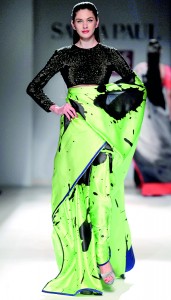Sunday Times 2
When in doubt, wear a sari
View(s):By Arnika Thakur
New Delhi (Reuters) – Just when you think that there is nothing more that you can do with a sari, someone will prove you wrong. On the first day of the Wills Lifestyle India Fashion Week in New Delhi, we saw saris with lipstick prints and telephone booth imprints, a sari wrapped around a bikini top and hot pants, and Peter Pan collars on sari blouses.

Model walks in a neon green designer saree with black printed work by Satya Paul during the Wills Lifestyle India fashion week (Reuters)
“It’s sexy, it’s a sari, it’s comfortable, but it is hot.” said designer Anupama Dayal, who brought her collection “Ishq-e-Dilli” (“Delhi Passion”) to the show.
The sari, said to be 5,000 years old and wearable in more than 80 ways, has found favour with Indian designers for a long time, and now young designers are taking a fancy to it.
Masaba Gupta, the 24-year old designer who opened the show with her debut collection for the Satya Paul label, had saris featuring colour blocking, splashes of neon and quirky prints.
“We tried to characterise a girl who was fun and young and quirky, since the main clientele of Satya Paul has always been someone who is older, someone who is above the age of 30,” Masaba said. “We repositioned the brand and made it for a young girl who loves colour and loves print.”
Bollywood has contributed to the growing popularity of saris among young women. Popular actresses such as Sonam Kapoor and Vidya Balan have been spotted in unconventional saris, and Aishwarya Rai wore saris at Cannes. Celebrities elsewhere have too. Last year, Lady Gagasported a version of a sari during her India trip. The Pussycat Dolls, Paris Hilton and Naomi Campbell all have been spotted in a sari. Burlesque queen Dita von Teese wore a sheer one on her trip to Delhi. Indian designers have tried their hand at Western designs, but there are few success stories. To stay in business with the Indian market, designers must work with traditional clothing for a new generation of women who are well travelled and exposed to global styles and trends.
It’s not just saris. The Ishq-e-Dilli collection featured clothes inspired by the Mughal era, targeting destination weddings, but with lighter embroidery and more suited to contemporary styles.
“Not everyone wants to wear something that weighs 20 kilos, something they can’t even walk in and so much jewellery,” Dayal told reporters. “It’s for an unusual wedding, for an unusual life, which is slowly becoming most of our lives.”
Designer Nikasha Tawadey experimented with traditional clothes as well. Her collection “Raat ki raani” (Queen of the Night) had sheer pants with kurtas, dhoti pants and sharara jumpsuits.
“You could wear a sharara jumpsuit and go clubbing. A sari or a velvet Patiala can be worn to a nightclub. The concept just needs to change,” said Nikasha.
Follow @timesonlinelk
comments powered by Disqus



















